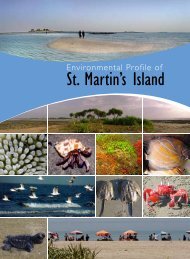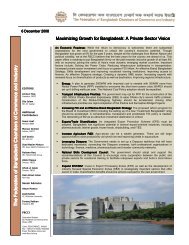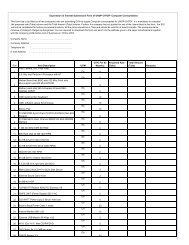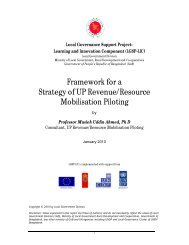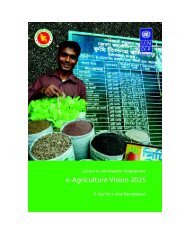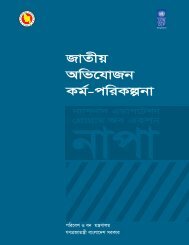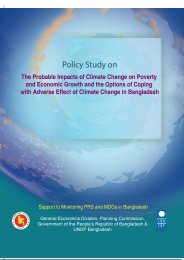Study Tour Tanguar Haor Draft
Study Tour Tanguar Haor Draft
Study Tour Tanguar Haor Draft
Create successful ePaper yourself
Turn your PDF publications into a flip-book with our unique Google optimized e-Paper software.
The presentation on<br />
<strong>Study</strong> <strong>Tour</strong> to <strong>Tanguar</strong> <strong>Haor</strong><br />
and Borodoi-Kastogonga<br />
Borodoi Kastogonga Group<br />
Jalmohal of Sunamganj District<br />
Presented by:<br />
ECAMU-CWBMP<br />
Hakaluki <strong>Haor</strong> Site
Activities during the trip:<br />
- Visiting Roa Beel, Beel,<br />
Hatirgada Beel<br />
and Rupabui Beel of <strong>Tanguar</strong> <strong>Haor</strong><br />
- Visiting Borodoi-Kastogonga<br />
Borodoi Kastogonga<br />
Group Jalmohal under Sunamganj<br />
District.<br />
- Meeting with District<br />
Administration of Sunamganj<br />
- Press conference
Introducing Introducing with with Sunamganj Sunamganj District District Administration Administration at at<br />
Circuit Circuit House House Conference Conference Room<br />
Room
Resource Management System in past<br />
in <strong>Tanguar</strong> <strong>Haor</strong> and :<br />
- Before declaration of <strong>Tanguar</strong> <strong>Haor</strong> as the<br />
second ramsar area, it was normally leased<br />
out by DC, Sunamganj and resources were<br />
collected by leases through traditional ways.<br />
- Then population and varieties of fish and<br />
waterfowls were reducing<br />
- Swamp forests of the kandas were<br />
decreasing due to excessive and unwise<br />
harvest.
Resource Management System in past<br />
in Borodoi-Kastogonga<br />
Borodoi Kastogonga Group<br />
Jalmohal: Jalmohal:<br />
- In past it was leased out by Sunamganj<br />
District Administration and leases harvest<br />
fish and managed the beel through<br />
traditional ways.<br />
- Then varieties and population of fish,<br />
resident and migratory waterfowls and<br />
swamp forests in kandas were decreasing.
Resource Management System at present at<br />
<strong>Tanguar</strong> <strong>Haor</strong>:<br />
- After declaration of ramsar area, beels of<br />
<strong>Tanguar</strong> <strong>Haor</strong> has been directly managed by DC,<br />
Sunamganj.<br />
Sunamganj<br />
- Exists guarding of police and BDR.<br />
- Harmful gears are banned, swamp plantation<br />
cutting is restricted.<br />
- Population of fishes, waterfowls and swamp<br />
forests are increasing day by day.
Resource Management System at<br />
present at Borodoi-Kastogonga<br />
Borodoi Kastogonga Group<br />
Jalmohal: Jalmohal<br />
- At present, Borodoi-Kastogonga<br />
Borodoi Kastogonga Group<br />
Jalmohal was leased out first time for three<br />
years and then for five years under<br />
development scheme.<br />
- The leases re-excavated re excavated the beel and<br />
managed through a good manner to<br />
improve biodiversity.<br />
- Several species of resident and migratory<br />
waterfowls observed in the area.
Pile in water and reeds in the kandas of Borodoi- Borodoi<br />
Kastogonga Group Jaqlmohal
Community access to the resources of<br />
<strong>Tanguar</strong> <strong>Haor</strong>:<br />
- Massive community access for fishing is not<br />
allowed in the <strong>Tanguar</strong> <strong>Haor</strong>.<br />
- Poor and subsistent fishers can catch fish in the<br />
haor by using pull net ( (thela thela jal), jal),<br />
cast ( (Felon Felon jal) jal)<br />
net, etc.<br />
- The fishers can meet their fish demand from the<br />
caught fish and sometimes they can sale.<br />
- Community access for swamp forests and reed<br />
collection is fully prohibited.<br />
- During monsoon, it becomes a suitable waterway<br />
by boat for the people surrounding area.
Community access to the<br />
resources of Borodoi-Kastogonga<br />
Borodoi Kastogonga<br />
Group jalmohal: jalmohal<br />
- Only in the monsoon, fishers have access<br />
to fish in the beel and its adjacent area.<br />
- During dry season fishing is not allowed in<br />
the beel but rice cultivation is allowed in the<br />
periphery.<br />
- Fishing guards are recruited from the<br />
fisher community around the beel.<br />
beel
Strengths for the Management System of<br />
<strong>Tanguar</strong> <strong>Haor</strong>:<br />
- As protection is one of the major parts of<br />
biodiversity management, the authority for<br />
<strong>Tanguar</strong> <strong>Haor</strong> management has been doing it very<br />
strictly and in good manner, which makes the haor<br />
rich in biodiversity. It is on of the strengths for<br />
biodiversity management system of <strong>Tanguar</strong> <strong>Haor</strong>.<br />
- Officers, who are involved in resource<br />
management is dedicated.<br />
- The Government of Bangladesh made the haor<br />
lease free. So it is proved that the Government of<br />
Bangladesh has willingness to protect biodiversity<br />
of <strong>Tanguar</strong> <strong>Haor</strong>.
Strengths for the Management System of<br />
Borodoi-Kastogonga<br />
Borodoi Kastogonga Group Jalmohal: Jalmohal<br />
- The leases have willingness to conserve<br />
biodiversity of the beel<br />
- The district administration supported them to do<br />
it.
Weakness for the Management System of<br />
<strong>Tanguar</strong> <strong>Haor</strong>:<br />
- It has been observed during the trip at <strong>Tanguar</strong><br />
<strong>Haor</strong> that some current net still has been used for<br />
fishing, which was banned as one of the harmful<br />
gears. Therefore, it is assumed that protection is<br />
not only the sustainable way to manage the<br />
resources of Tangaur <strong>Haor</strong>.<br />
- The local haor dependent community might be<br />
motivated and involved with the biodiversity<br />
management system of Hakaluki <strong>Haor</strong>.<br />
- Wastage of coal mining, which pollutes water<br />
coming from Tekerghat areas, is another threat for<br />
the management system.
Weakness for the Management<br />
System of Borodoi-Kastogonga<br />
Borodoi Kastogonga Group<br />
Jalmohal: Jalmohal<br />
- After investment of huge money the<br />
jalmohal might be leased out to another<br />
lease, makes the existing lease confused.<br />
- The leases have no enough knowledge to<br />
manage the beel for attracting eco-tourists<br />
eco tourists. .
BIOLOGICAL STATUS OF RESOURCES<br />
Overall situation:<br />
- The biological status of <strong>Tanguar</strong> <strong>Haor</strong> and<br />
Borodoi-Kastogonga<br />
Borodoi Kastogonga Group Jalmohal were observed<br />
well.<br />
- Varieties swamp plants and reeds in kandas of<br />
beels, beels,<br />
broad and short leaved floating, submerged<br />
aquatic vegetations in the beels. beels.<br />
- No human disturbance observed in whole the<br />
haor, so waterfowls and fish movement was<br />
frequent and fearlessness.
Plant biodiversity of<br />
Tangauar <strong>Haor</strong>:<br />
- Due to lack of human and cattle<br />
disturbance, huge, hijol, hijol,<br />
karach, karach,<br />
bantulshi, bantulshi,<br />
ghutghuitta,<br />
ghutghuitta,<br />
nol and other<br />
unknown grasses were observed in<br />
kandas of beels. beels.<br />
- Water was full of submerged and<br />
floating vegetation like singra, singra,<br />
shapla, shapla,<br />
makhna, makhna,<br />
etc. etc.
Floating aquatic vegetation in <strong>Tanguar</strong> <strong>Haor</strong>
Vegetation type and waterfowls in the kandas of<br />
<strong>Tanguar</strong> <strong>Haor</strong>
Plant biodiversity of Borodoi- Borodoi<br />
Kastogonga Group Jalmohal: Jalmohal<br />
- Due to lack of human and cattle<br />
disturbance, huge bantulshi, bantulshi,<br />
nol nol and other<br />
unknown grasses were observed in the<br />
kandas of the beel. beel.<br />
- Water was full of submerged and floating<br />
vegetations like singra, singra,<br />
shapla, shapla,<br />
makhna, makhna,<br />
etc.
Makhna in Borodoi-Kastogonga<br />
Borodoi Kastogonga Group Jalmohal
Fish biodiversity <strong>Tanguar</strong> <strong>Haor</strong>,<br />
Borodoi-Kastogonga<br />
Borodoi Kastogonga Group Jalmohal :<br />
- Due to existing strict protection, fish<br />
diversity and population has been increasing<br />
day by day in <strong>Tanguar</strong> <strong>Haor</strong>, Borodoi- Borodoi<br />
Kastogonga Group Jalmohal and its adjacent<br />
areas.<br />
- Both the areas are an important fish<br />
breeding centres in the country. - - Due to<br />
lack of fishing, no fish species observed<br />
during the trip except some small fishes like<br />
puti, puti,<br />
chela, chela,<br />
etc. jumped out of water.<br />
water
Wildlife biodiversity of <strong>Tanguar</strong> <strong>Haor</strong>: <strong>Haor</strong><br />
- Migratory igratory ducks like Eurasian Wigeon (Anas Anas<br />
penelope), penelope),<br />
Common Coot ( (Fulica Fulica atra), atra),<br />
Brown-<br />
headed Gull ( (Larus Larus brunnicephalus), brunnicephalus),<br />
Ruddy<br />
Shelduck (Tadorna Tadorna ferruginea) ferruginea)<br />
- Resident waterfowls like Spot-bill Spot bill Duck ( (Anas Anas<br />
poecilorhyncha), poecilorhyncha),<br />
Pheasant-tailed Pheasant tailed Jacana<br />
(Hydrophasianus<br />
Hydrophasianus chirurgus), chirurgus),<br />
Bronzed-winged<br />
Bronzed winged<br />
Jacana ( (Metopidus Metopidus indicus), indicus),<br />
Common Moorhen<br />
(Gallinula Gallinula chloropus), chloropus),<br />
Little Grebe ( (Trachybaptus<br />
Trachybaptus<br />
ruficollis), ruficollis),<br />
Grey Heron ( (Ardea Ardea cinerea); cinerea);<br />
- Raptor birds like Black Kite ( (Milvus Milvus migrans), migrans),<br />
Brahminy Kite ( (Haliastur Haliastur indus) indus)<br />
and Pallas’s Fish<br />
Eagle ( (Haliaeetus Haliaeetus leucoryphus)<br />
leucoryphus
Purple Swamphen (Kalim Kalim) ) in <strong>Tanguar</strong> <strong>Haor</strong>
Wildlife biodiversity of Borodoi-Kastogonga<br />
Borodoi Kastogonga<br />
Group Jalmohal: Jalmohal<br />
- Fulvous Whistling Duck ( (Dendrocygna<br />
Dendrocygna bicolor), bicolor),<br />
Lesser Whistling Duck ( (Dendrocygna<br />
Dendrocygna javanica), javanica),<br />
Little Grebe ( (Trachybaptus<br />
Trachybaptus ruficollis), ruficollis),<br />
Little<br />
Cormorant ( (Phalacrocorax<br />
Phalacrocorax niger), niger),<br />
Pond Heron<br />
(Ardeola Ardeola grayii), grayii),<br />
Ferroginous Pochard (Aythya Aythya<br />
nyroca), nyroca),<br />
Darter ( (Anhinga Anhinga melanogaster),<br />
melanogaster),<br />
- A Pallas’s Fish Eagle ( (Haliaeetus Haliaeetus leucoryphus)<br />
leucoryphus)<br />
called very loudly sitting on a stack nearer to the<br />
guard camp of the beel, beel,<br />
where we were sitting.
How the wetlands contributing to the<br />
national economy:<br />
- As <strong>Tanguar</strong> <strong>Haor</strong> and Borodoi-Kastogonga<br />
Borodoi Kastogonga Group<br />
Jalmohal are important fish breeding centres of<br />
the country, huge fishes breeds there and spread<br />
in the country through its outlets.<br />
- Fisher communities near the outlets and their<br />
tributaries able to harvest more fish after<br />
establishment of the present management<br />
system.<br />
- Due to undisturbed condition, migratory birds of<br />
various species come every year in those water<br />
bodies.<br />
- A lot of local and foreign eco-tourists eco tourists and<br />
researchers visit the haor every year.
Ecotourism potential: potential<br />
<strong>Tanguar</strong> <strong>Haor</strong> and Borodoi-Kastogonga<br />
Borodoi Kastogonga<br />
Group Jalmohal<br />
Jalmohal are rich in fish biodiversity<br />
and waterfowl diversity.<br />
Both the sites can be developed as eco-<br />
tourist areas through providing visitor<br />
facilities in safe distance
The main challenges for biodiversity<br />
conservation at <strong>Tanguar</strong> <strong>Haor</strong> are:<br />
- illiteracy of local haor dependent people,<br />
- poverty of the local haor dependant people<br />
and<br />
- biodiversity status may be disrupted after<br />
termination of the existing management<br />
system, because community motivation and<br />
involvement is absent.
Current (fishing) Net captured by guards of<br />
<strong>Tanguar</strong> <strong>Haor</strong>
The main challenges for conservation<br />
of the biodiversity of Borodoi-<br />
Kastogonga Group Jalmohal is:<br />
- Illiteracy and poverty of local people,<br />
who are depended on haor resources
Learnings<br />
For <strong>Tanguar</strong> <strong>Haor</strong><br />
- As a part of management system biodiversity resources<br />
can be managed through protection.<br />
- For further sustainability community motivation and<br />
involvement is a must for biodiversity conservation.<br />
Borodoi-Kastogonga<br />
Kastogonga Group Jalmohal<br />
For Borodoi<br />
Leases can take part in biodiversity conservation if the<br />
leases have willingness and the authority helps.
Recommendations:<br />
- To save the important mother fishery and<br />
migratory waterfowl areas, the management<br />
authority of <strong>Tanguar</strong> <strong>Haor</strong> might involve the local<br />
haor dependent people and take motivational<br />
activities.<br />
- The Borodoi-Kastogonga<br />
Borodoi Kastogonga Group Jalmohal can be<br />
made an eco-tourist eco tourist area through proper<br />
management and development of visitor facilities.<br />
- The district administration might lease out the<br />
Borodoi-Kastogonga<br />
Borodoi Kastogonga Group Jalmohal to the same<br />
lease again.
Photographs of <strong>Tanguar</strong> <strong>Haor</strong>
Thank You



